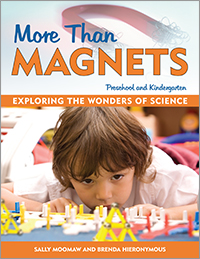More than Magnets : Exploring the Wonders of Science in
Preschool and Kindergarten by Sally Moomaw and Brenda Hieronymus, published by
Redleaf Press in 1997.
A review by the NAEYC Early Childhood Science
Interest Forum.
 Explore simple machines with your
children, enhance the learning opportunities at your science table, improve
your conversations with science focused open-ended questions. More than Magnets,
is an excellent resource for classroom teachers of children 3 to 5. With 117
activities ranging from physical to life, and chemical sciences, there is a
rich array of opportunities to enhance science learning throughout the pre-K classroom
and curriculum. The introduction lays out the authors’ approach, “Whole
Science”, offering a Piagetian view of child development and explaining what
young children are able to understand scientifically. Throughout the book the
authors work to build the readers understanding of the science concepts being
explored and what young children might learn about them.
Explore simple machines with your
children, enhance the learning opportunities at your science table, improve
your conversations with science focused open-ended questions. More than Magnets,
is an excellent resource for classroom teachers of children 3 to 5. With 117
activities ranging from physical to life, and chemical sciences, there is a
rich array of opportunities to enhance science learning throughout the pre-K classroom
and curriculum. The introduction lays out the authors’ approach, “Whole
Science”, offering a Piagetian view of child development and explaining what
young children are able to understand scientifically. Throughout the book the
authors work to build the readers understanding of the science concepts being
explored and what young children might learn about them.
Activities are organized in Chapters
that include Science Displays, Machines and Pendulums, Science at the Sensory
Table, Art, Music, Cooking, and Gross Motor. Some activities stand alone, such
as “A Spring Tradition: Varieties of Seeds.” In the Science Displays chapter,
this activity provides an overview of what children might learn about seeds and
the plants that grow from them. It lists the materials needed and the sequence
for implementation. It also describes what to look for in the children’s
response, a few questions to extend thinking, and Modifications that
incorporate literacy and documentation. Finally it suggests “Integrated Curriculum
Activities”. Some of these suggestions extend the learning into other areas of
the curriculum while others extend science learning.
In contrast, some of the activities
are sequenced to deepen children’s science understanding over time. An example
is in the Machines and Pendulums chapter. Six activities take children from an
introduction of balls and ramps to an exploration of the effect of ramp texture
on the speed of vehicles. Each activity follows the same format and includes
detailed descriptions of the materials needed and a “Sequence for
Implementation.” There is much guidance to help teachers enhance science
learning. Starting with information about the science itself and what children
might learn about it. There are also typical child responses gathered from a
field test of the activities. One of the strengths of these instructions is the
excellent questions for the teachers to use when promoting children’s
scientific thinking. “Modifications” and “Integrated Curriculum Activities”
suggest additional ways to enrich the science learning. Finally, “Helpful
Hints” address ways to make the activity safe for the children as well as ways
to adjust for different developmental levels.
We would recommend that users of this
guide allow children some time to explore the materials in a more open-ended
way at times, allowing them to experiment and trying out their own ideas. For
example, the ramps sequence is carefully constructed to focus children on
particular concepts such as momentum or friction. While there is value to this
structure, children would also benefit from time to more openly explore in
order to become familiar with the materials. The interests and ideas revealed
in their exploration might suggest a different sequence for the activities. In
this case the inquiry would be driven by the children and thus enrich their
ability to consider the hows and whys of their experience, see patterns, and make meaning.
Written before the New Generation
Science Standards (NGSS), direct connections are not made to the learning
continuum, however the experiences cover a wide range of content in the
physical, life, and chemical sciences. The science concepts introduced easily
connect to later learning as presented in NGSS. Most importantly, the authors
present an inquiry-based approach to learning involving three key elements of
the inquiry process - hands-on explorations, documentation, and discussion.
